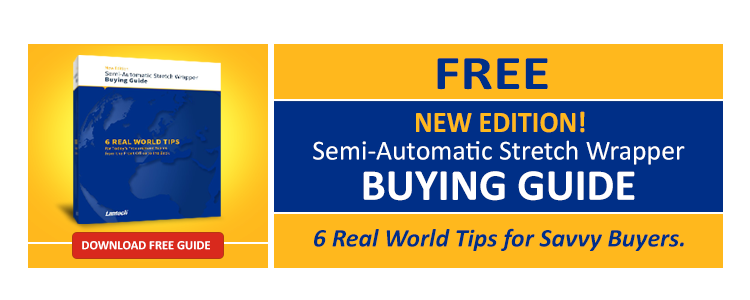When searching for the perfect stretch wrapper, you’re likely faced with an overwhelming amount of machine choices. For a lot of people, it’s important to buy a high-quality machine. High quality means the machine is safe, easy-to-use and requires minimal maintenance. But people shouldn’t forget about getting the most value out of a machine and the features that make it efficient.
 We’ve narrowed down the features of a stretch wrapper that will make the biggest economical difference in your loading dock, whether you’re wrapping 50 loads or 500 loads a day. Many features can save money over the long run and even, in many cases, pay for the entire machine in less than a couple of years.
We’ve narrowed down the features of a stretch wrapper that will make the biggest economical difference in your loading dock, whether you’re wrapping 50 loads or 500 loads a day. Many features can save money over the long run and even, in many cases, pay for the entire machine in less than a couple of years.
Here are some ideas to help you visualize which features actually add efficiency.
- Simple Automation saves an average customer at least $50,000 in labor over the first five years of ownership. A cut and clamp unit cuts the film at the end of the wrap cycle and attaches the film to the load at the start of the cycle. This means that your operator remains on the forklift and uses a remote control to start the machine. He can now perform another task while the load wraps (e.g., fetch another load, print shipping labels, complete bill-of-ladings).
- A load-to-pallet bonding device can help prevent in-transit damage, which costs companies billions of dollars every year. This device can save an average customer $30,000 – otherwise lost to damage from loads sliding off their pallets – over the economic life of a stretch wrapper. Special rollers apply a cable of film right below the top of your pallet, creating a strong bond between the load and pallet. Without a proper load to pallet bond, you run the risk of the load sliding off its pallet during transit and getting damaged. They may fall apart or collide with neighboring loads.
- A powered pre-stretch film delivery system can reduce film costs by at least 50 percent. Pre-stretch is the process of elongating film and enhancing the yield of the film. It occurs when two rollers in the film delivery system turn at two different speeds and cause the film to stretch. An average customer wrapping 50 loads – who made the switch from hand wrapping or from a machine without pre-stretch – can save at least $50,000 in film over 10 years.
- Conveyor systems help avoid bottle necks, especially if you plan on wrapping one load immediately after the next. After one load is wrapped, it’s pushed off to an exit conveyor. The forklift operator can now place another load on the turntable without having to move the completed load out of the way. An average customer can save about 30 seconds of labor per load from not having to double handle it, which equates to about $15,000 over seven years. To go a step further, you can even add in-feed conveyors to some stretch wrappers.
- Stretch wrappers with scales built into their turntables can eliminate 30 seconds to 1.5 minutes of double handling loads from a stretch wrapper to a platform scale. The labor savings over seven years for a typical user equates to $11,000 to $25,000. If you consistently know the weight of your loads, you avoid paying less-than-truckload (LTL) re-weigh fees. You can even use a smart phone app to control the weight indicator and store weight information without having to leave the forklift.
Even though some features may bump up the price of a stretch wrapper, you’ll barely notice the price difference over the long run. Spreading the cost of productivity improving features over thousands of loads during its economic life, yields a low cost per load wrapped. If you invest $2,000 in productivity improvements, it will cost you less than 2 cents per load over the course of 10 years.
It’s simple. Invest up front in a machine with features that have a lot of bang for their buck.
For more information on how stretch wrappers can save you money, go to lantech.com.
This post was published on March 4, 2015 and updated on October 26, 2018.
March 4, 2015

